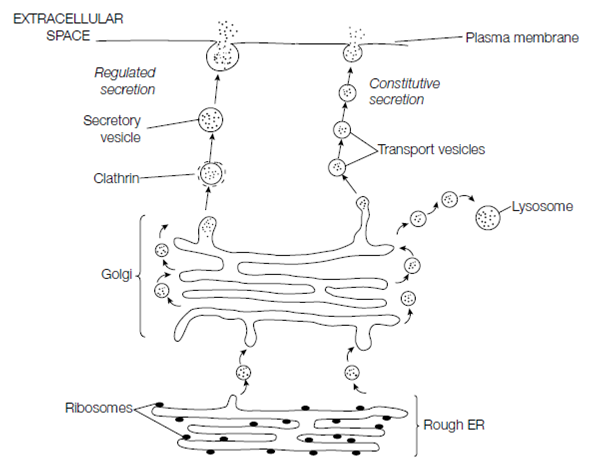Exocytosis
A cell frequently wants to secrete larger molecules than can be accommodated through the transport systems dealt with in Topic E3. Exocytosis obtains to the movement of proteins out of the cell across the plasma membrane into the extracellular space. The Proteins intended to be secreted from the cell are translated on ribosomes attached to the RER. Membrane-bound vesicles containing these proteins then bud off from the RER, migrate by the cytosol and fuse with the membrane of the Golgi apparatus that is shown in the Figure. On transport by the endoplasmic Golgi and reticulum apparatus, several post- translational modifications to the proteins take place, like as glycosylation.
The Golgi apparatus is the main sorting center of the cell where lipids and proteins are packaged into discrete vesicles and then goaled to the appropriate category of the cell. For instance, vesicles containing lysosomal proteins will be targeted to the lysosomes. If the vesicles contain no specific targeting signal they will migrate by the cytosol to the plasma membrane the so-called constitutive secretory or default way. Transport vesicles destined for the plasma membrane in the constitutive secretory path leave the Golgi apparatus in a steady stream. Membrane proteins and lipids in these vesicles give new material for the plasma membrane, although the soluble proteins inside the vesicles are secreted to the extracellular space. Overall cells have this constitutive secretory path.
In certain cells, moreover, an additional secretory path exists, the regulated secretory pathway. This pathway is found mostly in cells which are specialized for secreting products rapidly on demand in response to a particular stimulus. For instance, the hormone insulin and digestive enzymes are secreted through the pancreas, although neurotransmitters are secreted through nerve cells. In these cells like substances are initially stored in secretory vesicles that form

Figure: Exocytosis of proteins by the constitutive and regulated secretory pathways.
through clathrin-coated budding from the Golgi apparatus. The clathrin coat then vesicles and the dissociates remain in the cytosol until signaled to release their contents on fusion with the plasma membrane.